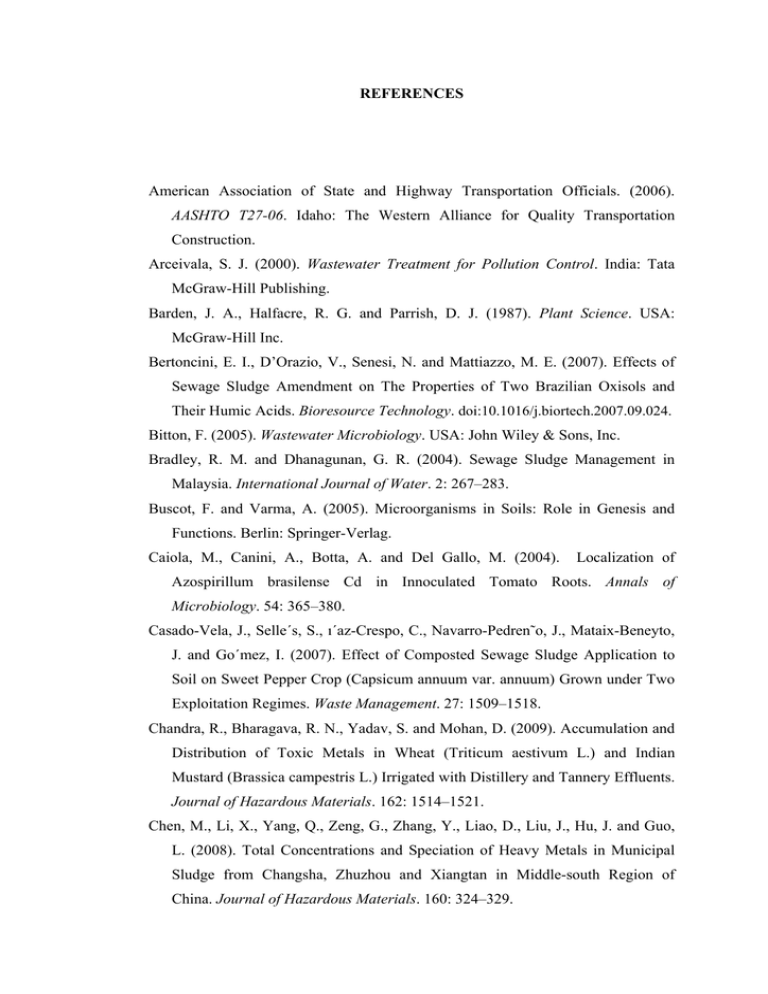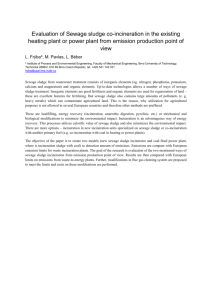REFERENCES American Association of State and Highway Transportation Officials. (2006). Construction.
advertisement

REFERENCES American Association of State and Highway Transportation Officials. (2006). AASHTO T27-06. Idaho: The Western Alliance for Quality Transportation Construction. Arceivala, S. J. (2000). Wastewater Treatment for Pollution Control. India: Tata McGraw-Hill Publishing. Barden, J. A., Halfacre, R. G. and Parrish, D. J. (1987). Plant Science. USA: McGraw-Hill Inc. Bertoncini, E. I., D’Orazio, V., Senesi, N. and Mattiazzo, M. E. (2007). Effects of Sewage Sludge Amendment on The Properties of Two Brazilian Oxisols and Their Humic Acids. Bioresource Technology. doi:10.1016/j.biortech.2007.09.024. Bitton, F. (2005). Wastewater Microbiology. USA: John Wiley & Sons, Inc. Bradley, R. M. and Dhanagunan, G. R. (2004). Sewage Sludge Management in Malaysia. International Journal of Water. 2: 267–283. Buscot, F. and Varma, A. (2005). Microorganisms in Soils: Role in Genesis and Functions. Berlin: Springer-Verlag. Caiola, M., Canini, A., Botta, A. and Del Gallo, M. (2004). Localization of Azospirillum brasilense Cd in Innoculated Tomato Roots. Annals of Microbiology. 54: 365–380. Casado-Vela, J., Selle´s, S., ı´az-Crespo, C., Navarro-Pedren˜o, J., Mataix-Beneyto, J. and Go´mez, I. (2007). Effect of Composted Sewage Sludge Application to Soil on Sweet Pepper Crop (Capsicum annuum var. annuum) Grown under Two Exploitation Regimes. Waste Management. 27: 1509–1518. Chandra, R., Bharagava, R. N., Yadav, S. and Mohan, D. (2009). Accumulation and Distribution of Toxic Metals in Wheat (Triticum aestivum L.) and Indian Mustard (Brassica campestris L.) Irrigated with Distillery and Tannery Effluents. Journal of Hazardous Materials. 162: 1514–1521. Chen, M., Li, X., Yang, Q., Zeng, G., Zhang, Y., Liao, D., Liu, J., Hu, J. and Guo, L. (2008). Total Concentrations and Speciation of Heavy Metals in Municipal Sludge from Changsha, Zhuzhou and Xiangtan in Middle-south Region of China. Journal of Hazardous Materials. 160: 324–329. 111 Chen, W., Chang, A. C., Wu, L., and Zhang, Y. (2007). Metal Uptake by Corn Grown on Media Treated with Particle-size Fractionated Biosolids. Science of The Total Environment. 392: 166 –173. Cecil, L., Zenz, D. R., Tata, P., Kuchenrither, R., Malina, Jr. J. F. and Sawyer, B. (1998). Municipal Sewage Sludge Management: A Reference Text on Processing, Utilization and Disposal. USA: Technomic Publishing. Dhir, R. K., Limbachiya, M. C. and McCarthy, M. J. (2001). Recycling and Reuse of Sewage Sludge. London: Thomas Telford Publishing. Economic Planning Unit. (2006). 9th Malaysia Plan, 2006-2010. Malaysia: Prime Minister’s Department. Eisler, R. (2000). Handbook of Chemical Risk Assessment: Health Hazards to Humans, Plants, and Animals. USA: CRC Press. Environment Protection Agency. (1997). Land Application of Biosolids: Process Design Manual. USA: Environmental Protection Agency Office of Science and Technology. Environment Protection Agency. (1989). POW Sludge Sampling and Analysis Guidance Document. USA: Environmental Protection Agency Office of Water. Environment Protection Agency. (1996). Standard Method 3050B. USA: Environment Protection Agency. Epstein, E. (2001). Compost Utilisation in Horticulture Cropping Systems. USA: Lewis Publishers. Epstein, E. (2003). Land Application of Sewage Sludge and Biosolids. USA: Lewis Publishers. European Scientific Cooperative on Phytotherapy. (2003). European Scientific Cooperative on Phytotherapy Monographs: The Scientific Foundation for Herbal Medicinal Products. New York: Thieme. Food and Agriculture Organization. (1992). Wastewater Treatment and Use in Agriculture. Food and Agriculture Organization of the United Nations Irrigation and Drainage Paper 47. Rome: Corporate Document Repository. Fernandes, S. A. P., Bettiol, W. and Cerri, C. C. (2005). Effect of Sewage Sludge on Microbial Biomass, Basal Respiration, Metabolic Quotient and Soil Enzymatic Activity. Applied Soil Ecology. 30: 65–77. 112 Frost, H. L. (2001). Land Application, Biological Decontamination, and Speciation of Metal-laden Sewage Sludge. Doctor of Philosophy, University of Notre Dame. Indiana, United States. Fuentes, A., Lloréns, M., Saéz, J., Aguilar, M. I., Ortunõ, J. F. and Meseguer, V. F. (2008). Comparative Study of Six Different Sludges by Sequential Speciation of Heavy Metals. Bioresource Technology. 99: 517–525 Fytili, D. and Zabaniotou, A. (2008). Utilization of Sewage Sludge in EU Application of Old and New Methods - A Review. Renewable and Sustainable Energy Reviews. 12: 116–140. Geotechnical Engineering Bureau. (2007). GTM-24: Test Method for Determination of pH Value of Water or Soil by pH Meter. New York: New York State Department of Transportation. Gomez, A., Leschber, R. and L’hermite, P. (1986). Sampling Problems for The Chemical Analysis of Sludge, Soils and Plants. Great Britain: Elsevier Applied Science Publishers. Harrison, E. Z., Oakes, S. R., Hysell, M. and Hay, A. (2006). Organic Chemicals in Sewage Sludges. Science of the Total Environment. 367: 481–497. Heenan, D. P. and Campbell, L. C. (1983). Manganese and Iron Interactions on Their Uptake and Distribution in Soybean (Glycine max (L.) Merr.). Plant and Soil. 70: 317 – 326. Indah Water Konsortium. (2008). Sewerage Statistics [Brochure]. Malaysia: Indah Water Konsortium Sdn. Bhd. Iskandar, I. K. (2000). Environmental Restoration of Metals-contaminated Soils. USA: CRC Press. Jing, Y., He, Z. and Yang, X. (2007). Role of Soil Rhizobacteria in Phytoremediation of Heavy Metal Contaminated Soils. Journal of Zhejiang University SCIENCE B. 8: 192 – 207. Johannesson, G. H. (1999). Sewage Sludge Characterisation and Evaluation of P Availability under Greenhouse Conditions. Master of Science, University of Guelph. Ontario, Canada. Kaya, C. and Higgs, D. (2002). Response of Tomato (Lycopersicon esculentum L.) Cultivars to Foliar Application of Zinc when Grown in Sand Culture at Low Zinc. Scientia Horticulturae. 93: 53 – 64. 113 Kingsland, S. E. (1995). Modeling Nature: Episodes in The History of Population Ecology. Chicago: University of Chicago Press L’hermite, P. (1991). Treatment and Use of Sewage Sludge and Liquid Agricultural Wastes. Northern Ireland: Elsevier Science Publishers. Li, S., Zhang, K., Zhou, S., Zhang, L. and Chen, Q. (2008). Use of Dewatered Municipal Sludge on Canna Growth in Pot Experiments with A Barren Clay Soil. Waste Management. doi:10.1016/j.wasman.2008.12.007. Mohd Hafizan bin Mohd Hafiz. (2009). Sewage Sludge Land Application for The Growth of Edible Plants. Master of Engineering, Universiti Teknologi Malaysia, Skudai, Malaysia. Navas, A., Machín, J. and Navas, B. (1999). Use of Biosolids to Restore The Natural Vegetation Cover on Degraded Soils in The Badlands of Zaragoza (NE Spain). Bioresource Technology. 69: 199 – 205. Natural Resources Conservation Service. (2004). Soil Survey Laboratory Methods Manual: Soil Survey Investigations Report No. 42. USA: Department of Agriculture. Nayek, S., Gupta, S. and Saha, R. N. (2010). Metal Accumulation and Its Effects in Relation to Biochemical Response of Vegetables Irrigated with Metal Contaminated Water and Wastewater. Journal of Hazardous Materials. doi:10.1016 / j.jhazmat.2010.01.126. New South Wales Agriculture. (2000). Acid Soil Management [Brochure]. Australia: New South Wales Department of Agriculture. Terry, N. (2000). Phytoremediation of Contaminated Soil and Water. USA: CRC Press. Ohashi, K., Bohgaki, T. and Shibuya, H. (2000). Antihypertensive Substance in The Leaves of Kumis Kucing (Orthosiphon aristatus) in Java Island. Journal of the Pharmaceutical Society of Japan. 120: 474–482. Pendias, H and Pendias, A. K. (2001). Trace Elements in Soils and Plants, 3rd Edition. USA: CRC Press. Prasad, M. N. V. (2004). Heavy Metal Stress in Plants: From Biomolecules to Ecosystems 2nd Edition. Berlin: Springer-Verlag. Prasad, M. N. V., Sajwan, K. S. and Naidu, R. (2006). Trace Elements in The Environment: Biogeochemistry, Biotechnology, and Bioremediation. USA: CRC Press. 114 Rattan, R. K., Datta, S. P., Chhonkar, P. K., Suribabu, K. and Singh, A. K. (2005). Long-term Impact of Irrigation with Sewage Effluents on Heavy Metal Content in Soils, Crops and Groundwater – A Case Study. Agriculture, Ecosystems and Environment. 109: 310–322. Reid, D. (1993). Paris Sewers and Sewermen: Realities and Representations. USA: Harvard University Press. Saskatchewan Environment. (2004). EPB 296: Land Application of Municipal Sewage Sludge Guidelines. Canada: Environmental Protection Branch. Sauchelli, V. (1969). Trace Elements in Agriculture. New York: Van Nostrand Reinhold Company. Šebánek, J. (1992). Plant Physiology. Czechoslovakia: Elsevier Science Publishers. Sharma, C. P. (2006). Plant Micronutrients. New Hampshire: Science Publishers. Shenker, M., Plessner, O. E. and Tel-Or, E. (2004). Manganese Nutrition Effects on Tomato Growth, Chlorophyll Concentration, and Superoxide Dismutase Activity. Journal of Plant Physiology. 161: 197 – 202. Sinha, S., Gupta, A. K. and Bhatt, K. (2007). Uptake and Translocation of Metals in Fenugreek Grown on Soil Amended with Tannery Sludge: Involvement of Antioxidants. Ecotoxicology and Environmental Safety. 67: 267 – 277. Singh, R. P. and Agrawal, M. (2007). Effects of Sewage Sludge Amendment on Heavy Metal Accumulation and Consequent Responses of Beta vulgaris Plants. Chemosphere. 67: 2229 – 2240. Singh, R. P. and Agrawal, M. (2010). Potential Benefits and Risks of Land Application of Sewage Sludge. Waste Management. 28: 347 – 358. Singh, R. P. and Agrawal, M. (2010). Variations in Heavy Metal Accumulation, Growth and Yield of Rice Plants Grown at Different Sewage Sludge Amendment Rates. Ecotoxicology and Environmental Safety. doi:10.1016 / j.ecoenv.2010.01.020. Smith, S. R. (2009). A Critical Review of The Bioavailability and Impacts of Heavy Metals in Municipal Solid Waste Composts Compared to Sewage Sludge. Environment International. 35: 142 – 156. Somers, I. I. and Shive, J. W. (1942). The Iron-manganese Relation in Plant Metabolism. Journal of Plant Physiology. 17: 582 – 602. Spellman, F. R. (1997). Wastewater Biosolids to Compost. USA: Technomic Publishing. 115 Standards & Industrial Research Institute of Malaysia. (1991). MS 1228: 1991. Malaysia: Standards & Industrial Research Institute of Malaysia. Stargrove, M. B., Treasure, J., and McKee, D. L. (2007). Herb, Nutrient, and Drug Interactions: Clinical Implications and Therapeutic Strategies. Missouri: Elsevier Health Sciences. Street, J. J. and Kidder, G. (1997). Fact Sheet SL-8: Soils and Plant Nutrition. Florida: Institute of Food and Agricultural Sciences, University of Florida. Sutapa, B. and Bhattacharyya, A. K. (2008). Heavy Metal Accumulation in Wheat Plant Grown in Soil Amended with Industrial Sludge. Chemosphere. 70: 1264– 1272. Wang, X., Chen, T., Ge, Y. and Jia, Y. (2008). Studies on Land Application of Sewage Sludge and Its Limiting Factors. Journal of Hazardous Materials. 160: 554–558. Warman, P. R. and Termeer, W. C. (2004). Evaluation of Sewage Sludge, Septic Waste and Sludge Compost Applications to Corn and Forage: Ca, Mg, S, Fe, Mn, Cu, Zn and B Content of Crops and Soils. Bioresource Technology. 96: 1029–1038. Wong, J. W. C., Lai, K. M., Fang, M and Ma, K. K. (1998). Effect of Sewage Sludge Amendment on Soil Microbial Activity and Nutrient Mineralization. Environmental International. 24: 935 – 943. Zheljazkov, V. D., Jeliazkova, E. A., Kovacheva, N. and Dzhurmanski, A. (2008). Metal Uptake by Medicinal Plant Species Grown in Soils Contaminated by A Smelter. Environmental and Experimental Botany. 64: 207 – 216.





